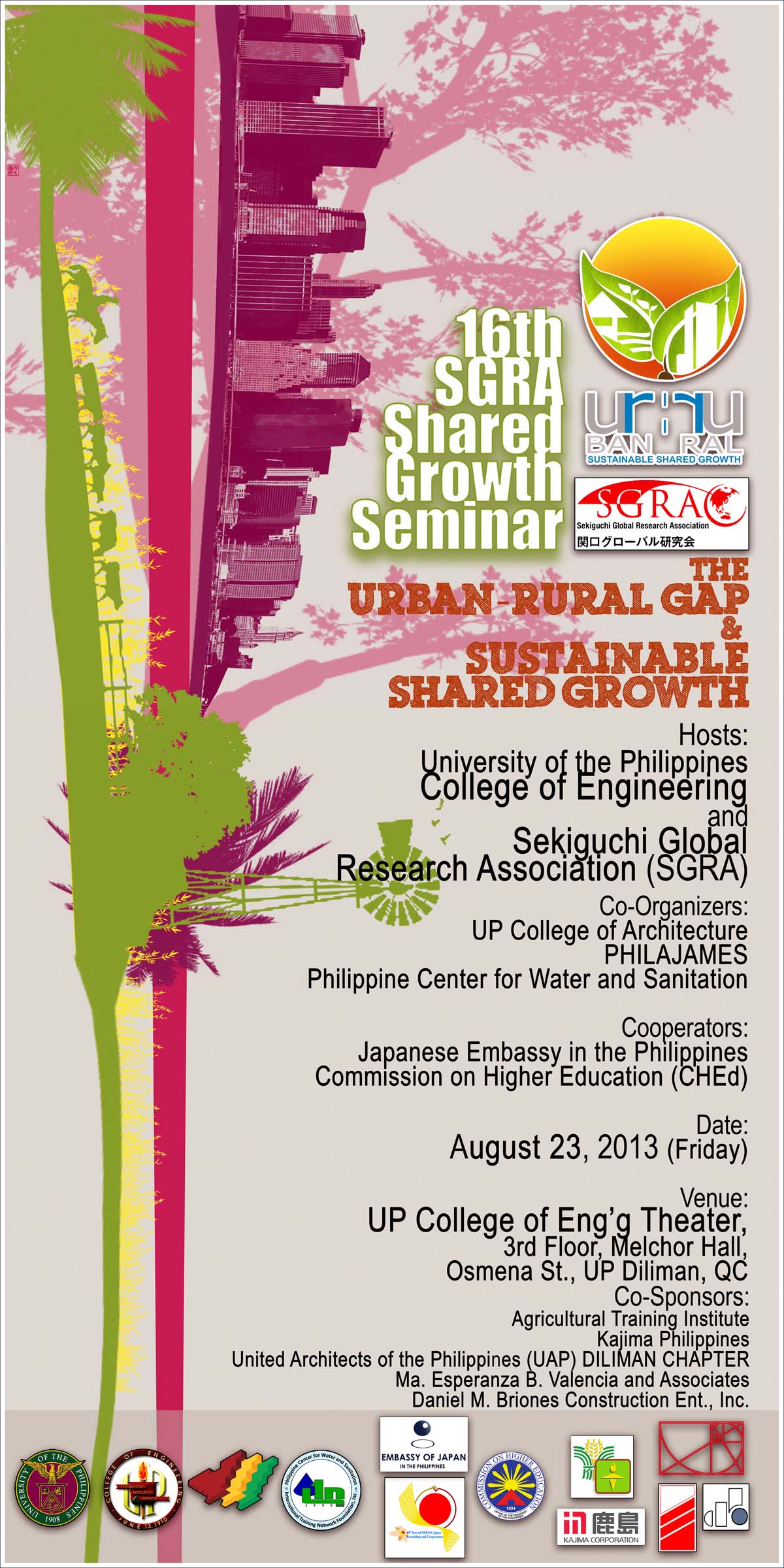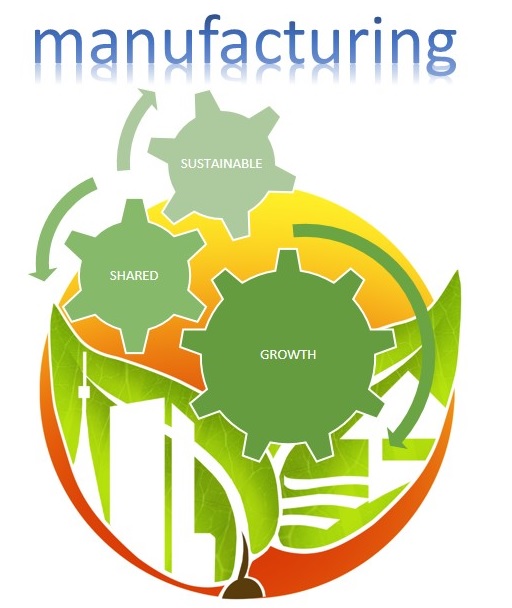Import-Substitution in Manufacturing for Sustainable Agriculture (DIRI Approach)
by Aladino C. Moraca (Executive Director, Ecological and Agricultural Development Foundation), Ramon C. Uy (President, RU Foundry)
Abstract
The concept of import substitution through fabrication and manufacturing of replacement parts for sugar mills was introduced by Mr. Ramon C. Uy, Sr. in 1970s to 1980s. He is the owner of RU Foundry and Machine Shop Corporation. The initiatives was strengthened when the company started to manufacture machineries and equipment in 1997 to date to support sustainable agriculture and waste management programs and projects.
Import substitution came into the consciousness of Mr. Uy as a means to promote local action to create wealth and push for decentralize development.
Filipinos has a preference of buying externally produced products rather than patronizing the use of locally manufactured inputs. Machineries and equipment needs of individuals or businesses can be produced and manufactured by local suppliers. Inconvenience or lack of information perhaps the reasons why machineries and agricultural inputs in our country are often purchased from the outside.
Approaches of import substitution engaged by RU Foundry and Machine Shop Corporation in partnership with Ecological and Agricultural Development Foundation, Inc. (EcoAgri) is to produce goods and services such as: safe and healthy food, organic fertilizer and water by adopting appropriate and renewable energy technologies. Products and machineries developed and manufactured are: shredder machine for biodegradable and non-biodegradable (waste management and composting facilities), hydraulic ram pump for water supply (drinking and irrigation), essential oil extractor, windmill for pumping water, post harvest support facilities and other appropriate and renewable energy technologies.
Production and manufacturing of heavy duty, easy to maintain and good quality machineries enhanced the flow of capital and resources in our assisted communities. The efforts played a critical role in achieving concrete results in spreading best farming practices anchored on the principles of sustainable agriculture.
Efforts of RU Foundry and Machine Shop Corporation and Ecological and Agricultural Development Foundation, Inc. (EcoAgri) adopting the DIRI Model displayed tangible outputs in addressing poverty issues and concerns. Concrete results are: creation of wealth and job opportunities, sustainable livelihood activities in the upland communities, and availability of locally manufactured machineries and equipment which is durable, easy to maintain and environment friendly.
Substituting demand for externally produced inputs with locally produced inputs is still our challenge and part of our advocacy to showcase promising approaches.
Profile:
ALADINO (NONOY) C. MORACA
Block 9, Lot 10, NGO Village, Brgy. Handumanan
Bacolod City, Negros Occidental, Philippines
Res. Tel. No. 34 707 4316
Office Tel. Nos. 444-1337/444-3286
Mobile: 09193442115
PERSONAL
Born: June 10, 1969, Barangay Tagukon, Kabankalan City, Negros Occidental, Philippines;
Age 44; Height 5’7 ; Weight 172 lbs.; Filipino; Male;
Married; Roman Catholic
International Exposure
• One of the Presenters on best practices on Renewable Energy Technologies/ Appropriate Technology during the World Water Forum 4 (WWF4) held in Mexico City on March 17-21, 2006. The activity was attended by at least 18,000 delegates all over the world.
• One of the Resource Speakers during the NGO’s, Private Sector and Farmers Conference held in Bali, Indonesia on May 09-11, 2006. Topic discussed: Appropriate Technologies Bolster Rural Economy
• Attended the International Expo (Exhibit of Essential Oil Products) held in Hongkong Convention Center last November 17-21, 2006. Introduction and presentation of Lemon Grass Oil Product to the international market was the main objective in participating the activity.
• One of the Presenters during the Innovations Based of Pyramid (IBOP) Conference held in Jakarta, Indonesia on June 10 to 12, 2010. Topic discussed: Turning Natural Wastes into Organic Fertilizer, Cheap and Affordable Fuel for Cooking.
Research Activities
• Inventory of Flora and Fauna in Ilog-Hilabangan Watershed Forest Reserve (2004). Assigned as Team Leader in the conduct of the study. One of the highlights of the study was the identification of sustainable livelihood options for implementation by the LGUs and other stakeholders in the area. The approach was to encourage communities participation and involvement in the protection and conservation of the watershed forest reserve.
• Development and improvement of the Eco-Pump/s as one of the renewable energy technologies popularize by Eco-Agri Development Foundation. Working model has been completed and ready for implementation.
• Improvement of biogas system. EcoAgri Development Foundation, Inc. successfully improved the design of the biogas model which is practical and appropriate for implementation in the rural areas.
• Development and improvement of an Essential Oil Distiller. Successfully improved the design of the Essential Oil Distiller. Installation of the system in one of the upland communities in Negros Occidental is an on-going research project of the EcoAgri Development Foundation, Inc. It is expected that the research project will create sustainable livelihood option of the upland farmers through the extraction of Lemon Grass Oil.
• Research and development activities on best practices on vermiculture/vermicomposting and organic foliar fertilizer production.
WORK EXPERIENCE/S
Executive Director
Ecological and Agricultural Development Foundation, Inc. (EcoAgri)
August 11, 2008 – to date
• Instrumental in the process of transforming at least 6,000 small farmers in the Province of Negros Occidental and in other provinces in the Philippines into a farmer entrepreneur through the promotion and implementation of renewable energy technologies and provision of additional revolving capital and support facilities wherein practices adopted is anchored on the principle and practices of Sustainable Agriculture/Organic Farming.
• Research and development activities lead to the development of an efficient and durable model of Hydraulic Ram Pump, Elephant Pump, Rope Pump, Biogas, Essential Oil Extractor, Rotary Weeder, Windmill for Water Pumping and Mechanical Presser for Eco-Charcoal production.
Technical Consultant
United Nations Industrial Development Organization (UNIDO)
April 01, 2013 – to date
Technical Consultant
RU Foundry and Machine Shop Corporation
August 11, 2008 – to date
Executive Director
Alternative Indigenous Development Foundation, Inc. (AIDFI)
April 04, 2004 - August 10, 2008
• Instrumental in the process of accessing funds and establishing partnership with the local, national and international institutions which lead to the implementation of various renewable energy development programs and projects of the Foundation.
• Ensures the implementation of programs and projects of the Foundation.
• Developed strategies and approaches to enhance implementation of the projects at the community level and to enhance efforts in mobilizing resources, networking and linkaging activities.
• Facilitates preparation of yearly operational plan, financial plan and human resource management plan for approval by the BOD.
• Involved in the research and development activities on renewable energy technologies.
Professor (Part-Time)
Graduate School of La Carlota City College, Negros Occidental
October, 2001 to March, 2003
Team Member
Multi-Sectoral Alliance for Development – Negros (MUAD-Negros)
March 16, 2001 to May 31, 2001
• Prepare project proposals and project feasibility studies related to potential community livelihood projects implemented in the Protected Area of Mount Kanla-on National Park.
Program Officer
Negros Economic Development Foundation, Inc.
August 01, 1998 - to date
• Facilitate Strategic Planning Sessions.
• Coordinate closely with the Finance Division on financial matters relative to the operations of various Income Generating Projects of the Foundation.
• Report directly to the Executive Director related to income generating projects and resource mobilization activities of the Foundation.
• Manages income generating projects.
• Ensure that monthly target are accomplished with proper use of manpower and resources.
• Regularly conduct monitoring and evaluation.
• Conduct seminars and training/s
• Facilitate preparation of Project Concepts and Project Proposals related to bio-diversity and climate change, enterprise development, health, renewable energy technologies, capability building, sustainable agriculture and agroforestry and genetic resources conservation of indigenous varieties of rice and vegetables for funding to various agencies/institutions. Nine (9) project concepts and proposals prepared were approved by various funding partners or funding agencies.
Local Training Officer
Negros Economic Development Foundation, Inc.
January 01, 1996 to July 31, 1998
• Conduct project assessment and evaluation of the Integrated Capability Building and Linkage Project of the Foundation.
• Evaluates community livelihood projects proposed by the community organizations.
• Facilitate and assist the officers of the community organizations in the conduct of assessment, planning and replanning.
• Facilitate in the conduct of seminars and training.
• Facilitate in the preparation of Training Proposals, Project Proposals, Training Design, Training Modules, Budget Plan, Accomplishment and Terminal Report.
Project Officer
Negros Economic Development Foundation, Inc.
April 06, 1992 to December 31, 1995
• Responsible in implementing the Special Development Project and Sectoral Integrated Resource Access and Distribution Program of Negros Economic Development Foundation, Inc.
• Perform community organizing and development works.
• Conduct assessment, monitoring and evaluation.
• Audit community-based projects.
• Provide technical and community organizing assistance and do net- working with the Local Government Units, Line Agencies and other Non-Government Organizations and Peoples Organization’s.
• Ensures that planned activities properly implemented.
Researcher/Agriculturist
Tuburan Technology and Research Center (TTRC)
June 01, 1990 to March 31, 1992
• Responsible in implementing the Research Program of Tuburan Technology and Research Center on sustainable agriculture and appropriate technology.
• Coordinate with the Finance, Extension and Training Program in conducting and undertaking the research studies.
• Formulate operational budget of the Research Program.
• Provide technical assistance with the personnel in-charge in the demonstration farm.
• Facilitates in the preparation of project feasibility studies, project proposals and training modules.
• Ensures that planned activities properly implemented.
EDUCATIONAL BACKGROUND
Eligibility
Licensed Agriculturist with PRC Registration No. 0012606
Graduate of Master in Business Administration (MBA)
University of Negros Occidental – Recoletos (UNO-R)
Bacolod City, Negros Occidental
School Year 1998-1999
Bachelor of Science in Agriculture (BSA) major in Agri-Business
Negros Occidental Agricultural College (NOAC)
Kabankalan City, Negros Occidental
(1986 –1990)
Secondary Education
Negros Occidental Agricultural College (NOAC)
Kabankalan City, Negros Occidental
(1982-1986)
Primary and Elementary Education
Brgy. Tagukon, Kabankalan, City Negros Occidental
(1976-1982)
Presentation Slides
Thank you for not plagiarizing. Support us by properly citing the title, author, and seminar (SGRA 16th Sustainable Shared Growth Seminar, "The Urban-Rural Gap and Sustainable Shared Growth", August 23, 2013, College of Engineering, University of the Philippines)

